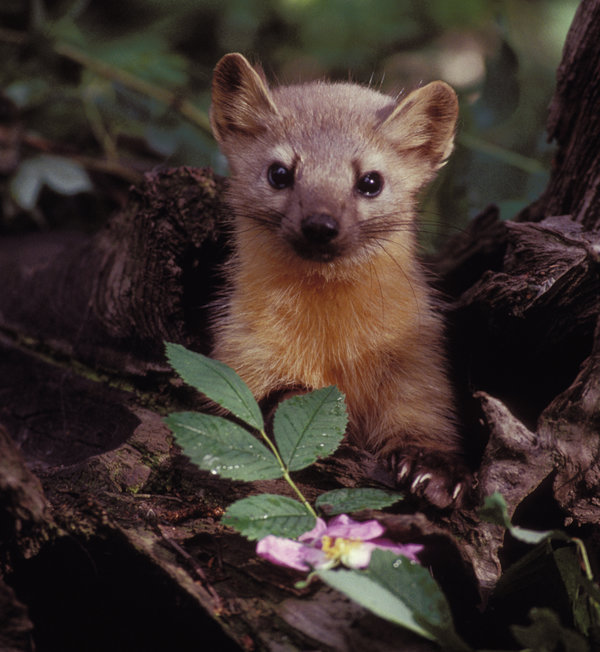
Photo by USFWS@USFWSNews
Service continues to work with partners for marten conservation
September 1, 2020 - The U.S. Fish and Wildlife Service has determined that the coastal distinct population segment of the Pacific marten, known as the coastal marten, warrants listing as a threatened species under the Endangered Species Act (ESA).
This secretive, cat-sized mammal in the weasel family lives in coastal Oregon and northern coastal California. It requires mature, structurally complex forest stands with a dense understory. Catastrophic wildfire and historic timber harvest activities threaten habitat of this type in the species’ range.
Historically, the coastal marten lived throughout the coastal forests of northwestern California and Oregon. These mammals have lost over 90 percent of their historical range and currently exist in four small and isolated populations.
The Service evaluated the threats to coastal marten populations including impacts from habitat loss, catastrophic wildfire, changing climate, vegetation management, exposure to toxins, predation, trapping, vehicle mortality and potential effects associated with small and isolated populations. After evaluating the latest scientific and commercial data, the Service concluded that the impact of these threats warrants listing the population as threatened.
“The Service worked closely with federal, state and local partners to help determine the best available science regarding this decision,” said Paul Souza, regional director for the Service’s California-Great Basin Region. “We are honored to work with such a robust and dedicated group of stakeholders to learn more about the species and find creative ways to conserve and recover the coastal marten, while reducing the potential regulatory burden on landowners.”
The Service and other federal, state and private partners are actively working to implement priority conservation actions from the recently completed conservation strategy in an effort to recover the coastal marten. High priority conservation actions include using assisted dispersal to establish new marten populations, protecting important movement corridors and other high value habitat, and conducting research and monitoring to enhance conservation efforts.
The Service will use all the inherent flexibilities of the Endangered Species Act to protect species without unduly burdening private landowners and industry. Accordingly, the Service has finalized a special rule under section 4(d) of the ESA to accompany this listing decision. Such 4(d) rules allow the Service to exempt certain activities from the restrictions imposed by the ESA. The Service recognizes that certain forest management activities (habitat management, firefighting activities, maintenance of fuel breaks, and activities to remove toxicants/other chemicals) can provide long-term conservation benefits for coastal marten populations, and do not warrant additional regulatory restrictions.
“Using all the tools of the ESA, we can protect a species without unduly burdening private landowners and the 4(d) rule accompanying this listing is a perfect example,” said Paul Henson, Oregon State Supervisor for the Service. “By allowing flexibilities for certain routine forest management activities that benefit coastal marten populations, this strengthens our public-private partnership in Oregon and California around many forest species. We look forward to further engaging with these private landowners on strategic collaboration to conserve the coastal marten and to keep working forests working.”
The Service is working with California State Parks, Green Diamond Resource Company and the Yurok tribe to develop three individual Memorandum of Understanding agreements tailored to each organization’s unique land management practices. The agreements provide commitments to conservation of existing marten habitat, research and monitoring, restoration of additional habitat and an emphasis on adaptive management to allow flexibility as we learn more about marten habitat and ecology.
“Green Diamond appreciates the alignment of public-private efforts with tribal, state and federal agencies for marten conservation on and near our California Timberlands,” said Jason Carlson, vice president and general manager for the Green Diamond Resource Company. “Green Diamond’s conservation partnership with the U.S. Fish and Wildlife Service under this Memorandum of Understanding builds on Green Diamond’s commitments to conservation, monitoring, research, and adaptive management included in our Marten Safe Harbor Agreement with the California Department of Fish and Wildlife.”
“We are committed to the implementation of proactive and coordinated conservation actions, working with the Service and other partners, with the goal to establish self-sustaining, interacting populations of coastal marten throughout their historic range,” said Amber Transou, natural resources program manager, California State Parks North Coast Redwoods District. “Our contributions, primarily through habitat protection, restoration and maintenance are consistent with the California State Park mission to help to preserve the states extraordinary biodiversity and protect its most valued resources.”
The final rule listing the coastal marten as a threatened species will publish in the Federal Register. The rule, comments and supporting documentation will be available at http:// www.regulations.gov under Docket No. FWS–R8–ES–2018–0076, or online at Arcata Fish and Wildlife Office.
The U.S. Fish and Wildlife Service works with others to conserve, protect, and enhance fish, wildlife, plants, and their habitats for the continuing benefit of the American people. For more information about our work and the people who make it happen, visit https://www.fws.gov/cno/ or connect with us via Facebook, Twitter, YouTube, and Flickr.
Source: U.S. Fish and Wildlife Service








